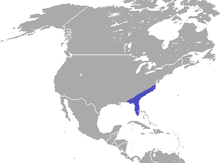Marsh rabbit
| Marsh rabbit | ||||||||||||
|---|---|---|---|---|---|---|---|---|---|---|---|---|

Marsh rabbit ( Sylvilagus palustris ) |
||||||||||||
| Systematics | ||||||||||||
|
||||||||||||
| Scientific name | ||||||||||||
| Sylvilagus palustris | ||||||||||||
| ( Bachman , 1837) |
The marsh rabbit ( Sylvilagus palustris ) is a species of mammal from the genus of cottontail rabbits within the hare-like species . It lives in wetlands in the eastern United States from Virginia to Florida , with a subspecies occurring in the Florida Keys .
features
The marsh rabbit is a relatively large species of cottontail rabbit. Chapman & Willner 1983 give an average head-torso length of 43.6 centimeters for the species , although they only measured five specimens. The tail length is 3.3 centimeters, the length of the hind feet 9.1 centimeters and the length of the ears (dried) 5.2 centimeters.
The coarse fur is dark brown, the feet are red-brown on the top and a little darker on the underside. The tail is short and inconspicuous, its underside is white.
distribution
The range of the marsh rabbit includes the wetlands on the east coast of the United States from Virginia to Florida to the Florida Keys .
Way of life
The marsh rabbit inhabits coastal swamp areas, which are often determined by brackish water . In the past, it was also often found in freshwater swamps, which are now largely drained. Within their habitat, the marsh rabbits are usually bound to cattails ( Typha ) and the water is the limiting factor in their distribution.
The species is nocturnal and lives solitary. During the day the rabbit sits motionless most of the time in a seat, which it leaves in the evening. The animals spend most of their time in the water and are very good swimmers; on land they tend to walk rather than hop. The mating and breeding season lasts the whole year and the females usually have six litters per year. A female gives birth to around 15 to 20 offspring per year.
Systematics
The marsh rabbit is assigned to the cottontail rabbit (genus Sylvilagus) as an independent species . It was first scientifically described in 1837 as Lepus palustris by the American natural scientist and priest John Bachman .
Within the species, the nominate form Sylvilagus palustris palustris and S. p. paludicola and the only found in the Florida Keys S. p. hefneri described three subspecies.
Hazard and protection
The Marsh rabbit is classified by the International Union for Conservation of Nature and Natural Resources (IUCN) as not endangered (least concern) due to the size of the population and the large distribution area. An exception is the subspecies S. p , which occurs in the Florida Keys . hefneri , which is classified as critically endangered by the IUCN.
supporting documents
- ↑ a b c Joseph A. Chapman, Gane R. Willner: Sylvilagus palustris . In: Mammalian Species . tape 153 , 1981, pp. 1–3 ( full text (PDF; 219 kB)). Full text ( Memento of the original from March 4, 2016 in the Internet Archive ) Info: The archive link was inserted automatically and has not yet been checked. Please check the original and archive link according to the instructions and then remove this notice.
- ↑ a b c d Joseph A. Chapman, Gerardo Ceballos: The Cottontails. In: Joseph A. Chapman, John EC Flux (Eds.): Rabbits, Hares and Pikas. Status Survey and Conservation Action Plan. (PDF; 11.3 MB) International Union for Conservation of Nature and Natural Resources (IUCN), Gland 1990; SS 106. ISBN 2-8317-0019-1 .
- ↑ a b c d Sylvilagus palustris in the IUCN Red List of Threatened Species 2012.2. Listed by: CA Faulhaber, Andrew T. Smith , 2008. Retrieved November 26, 2012.
- ^ John Bachman : Description of a new species of hare found in South Carolina. Journal of the Academy of Natural Sciences of Philadelphia 7, 1837; Pp. 194-199. ( Digitized version )
- ↑ Don E. Wilson & DeeAnn M. Reeder (eds.): Sylvilagus palustris ( Memento of the original from March 25, 2016 in the Internet Archive ) Info: The archive link was inserted automatically and has not yet been checked. Please check the original and archive link according to the instructions and then remove this notice. in Mammal Species of the World. A Taxonomic and Geographic Reference (3rd ed).
literature
- Joseph A. Chapman, John EC Flux (Eds.): Rabbits, Hares and Pikas. Status Survey and Conservation Action Plan. (PDF; 11.3 MB) International Union for Conservation of Nature and Natural Resources (IUCN), Gland 1990; SS 106. ISBN 2-8317-0019-1 .
- Joseph A. Chapman, Gane R. Willner: Sylvilagus palustris . In: Mammalian Species . tape 153 , 1981, pp. 1–3 ( full text (PDF; 219 kB)).
Web links
- Sylvilagus palustris inthe IUCN 2012 Red List of Threatened Species . Listed by: CA Faulhaber, Andrew T. Smith , 2008. Retrieved November 26, 2012.


